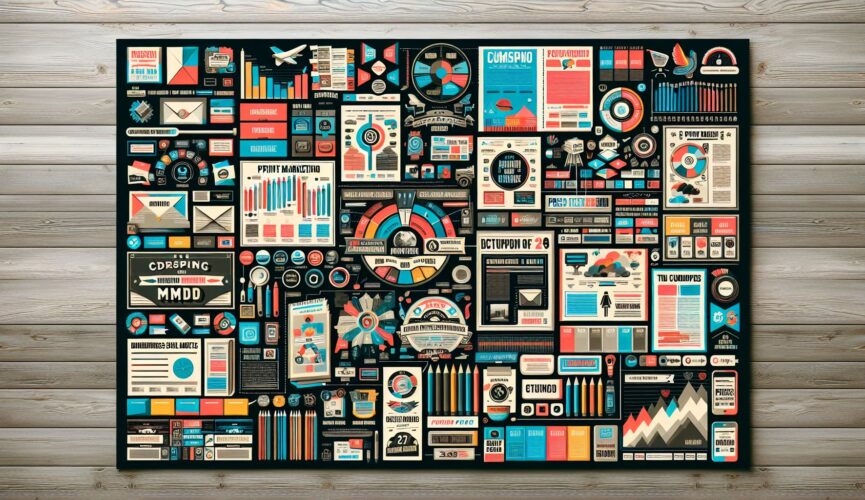In this digital age, it’s easy to think that all marketing should be done online. After all, social media, email campaigns, and search engine optimization provide a quick and cost-effective way to reach a wide audience. However, in the rush towards all things digital, there’s one underrated marketing tool that has stood the test of time – printed marketing materials.
Printed marketing materials encompass a range of tangible items such as business cards, brochures, flyers, posters, and even stickers. These physical creations have an inherent power to captivate and engage an audience. In this blog post, we will explore the benefits of using printed marketing materials, how to design them effectively, and why they remain relevant in today’s society.
Why Printed Marketing Materials Still Matter
In an era dominated by screens and digital overload, the touch, feel, and physical presence of printed marketing materials can make a lasting impact on prospective customers. Here are some reasons why they are still relevant and valuable:
1. Tangibility Enhances Memorability
Printed materials engage more of our senses – touch and sight especially. When we physically hold a well-designed brochure or business card, it creates a deeper connection than scrolling through yet another online ad. The tactile experience enhances memorability and increases the chances of a potential customer recalling your brand when the need arises.
2. Credibility and Trust
Printed materials give your business a sense of credibility and permanence. Being able to physically see and touch marketing materials instills a sense of trust and fosters legitimacy. This is particularly important for small businesses or startups trying to establish themselves in a competitive market.
3. Targeted Distribution
Printed marketing materials allow you to target specific demographics or geographical areas. Whether it’s handing out flyers at a local event or including brochures in targeted mailings, printed materials provide a tangible way to reach your audience directly. By strategically placing them in the hands of potential customers, you can effectively increase brand awareness.
Designing Effective Printed Marketing Materials
Now that we understand the importance of printed marketing materials, let’s dive into the key considerations for designing them effectively.
1. Define Your Objectives
Before starting the design process, identify your marketing goals and the specific audience you want to target. Are you aiming to generate sales, increase brand awareness, or simply provide information? By clarifying your objectives, you can tailor the design and content to meet the specific needs of your target audience.
2. Keep It Simple
When it comes to printed materials, simplicity is key. Ensure that your design is clean, uncluttered, and easy to digest. Use a limited color palette, readable fonts, and avoid overwhelming the reader with excessive information. Remember, the goal is to catch their attention and encourage further engagement, not to overwhelm them with unnecessary details.
3. Compelling Content
While aesthetics play a significant role in print design, compelling and concise content is equally important. Craft your message carefully, highlighting your unique value proposition and addressing the needs and pain points of your target audience. Use persuasive language and consider clever taglines to capture attention and leave a lasting impression.
4. Choose Quality Materials
Investing in high-quality materials is essential to create a positive brand image. Whether it is glossy or matte paper, thick cardstock for business cards, or durable materials for posters and banners, choosing quality materials enhances the perceived value of your brand. This attention to detail shows potential customers that you take your business seriously.
5. Consistency is Key
Ensure that the design of your printed marketing materials aligns with your overall brand identity. Consistency in colors, fonts, and logo usage across various printed materials helps build brand recognition and reinforces a sense of professionalism. By maintaining a cohesive visual language, you create a familiar and trustworthy presence in the minds of your target audience.
Conclusion
In a digital world filled with constant distractions, printed marketing materials offer a refreshing and effective way to engage potential customers. Their tangibility and physical presence allow for a deeper connection and can leave a lasting impression. By designing effective printed marketing materials and aligning them with your brand identity, you can showcase your professionalism and build trust with your target audience.
The next time you plan a marketing campaign, don’t overlook the significant impact that printed materials can have. Whether it’s a stylish business card, an informative brochure, or a captivating poster, embrace the art of print to make a lasting impression that digital marketing alone cannot achieve. Remember, a well-designed piece of print can set you apart from the competition and ultimately lead to meaningful connections with your customers.

